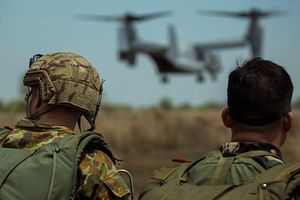On October 2, the United States and the Philippines officially began the launch of a newly named bilateral exercise. The holding of the fresh drills speaks to the steps both sides are continuing to take to adapt to the changing context of the treaty alliance under the reign of Philippine President Rodrigo Duterte.
As I have repeatedly noted in these pages, with the emergence of Duterte, we have witnessed some changes in the existing range of U.S.-Philippine military exercises, with some cancellations, additions, refocusing, and renaming (See: “How Much Can Duterte Wreck the US-Philippine Military Alliance?”).
A case in point is the U.S.-Philippine Amphibious Landing Exercise (PHILBEX). The last PHILBEX – an exercise that traditionally consisted of various phases, with recent iterations including a command post exercise, field training exercises, amphibious operations, combined arms training, civil-military operations, and humanitarian and civic assistance projects – took place in October 4 to 12 last year before it was canceled by Duterte. This year, it has been replaced by a new exercise called KAMANDAG (an acronym for the Tagalog phrase “Kaagapay Ng Mga Mandirigma Ng Dagat,” which translates in English roughly to “Alongside the Warriors of the Sea”).
The inaugural iteration of KAMANDAG launched this week and will take place from October 2 to October 11, even though both sides already had begun some joint civil assistance activities considered a preparatory part of the exercise as I noted earlier (See: “What’s in the New US-Philippines Military Exercise?”).
KAMANDAG, both sides have said, will focus on enhancing capabilities in terms of humanitarian assistance and disaster relief, internal security operations, and counterterrorism. Among these, counterterrorism has been of particular concern for the Philippines of late with the Marawi crisis that erupted in May (See: “Why Has the Philippines’ Military Struggled in its Terror Fight Under Duterte?”). Indeed, the United States and the Philippines just concluded the first iteration of their new, complex counterterrorism drill called Tempest Wind, which is just one of the examples of Washington’s assistance to its treaty ally in this respect as I have noted and Duterte himself has recently been acknowledging (See: “What Did the New US-Philippines Terror Drills Achieve?”).
Philippine Marine Corps (PMC) spokesperson Captain Maria Rowna Dalmacio said Friday that the exercises would be conducted in Clark and Basa air bases in Pampanga, Marines Barracks Camp Gregorio Lim in Ternate, Cavite; Crow Valley in Tarlac; Fort Magsaysay in Nueva Ecija; the Naval Education and Training Command in San Antonio, Zambales; and Aurora.
Engineers from the Japan Ground Self-Defense Force are also participating in the disaster rehabilitation and rural development projects in the exercise, reflecting the broader pattern of growing multilateralization of some U.S.-Philippine military interactions such as the Balikatan Exercises (See: “How Significant is the 2017 US-Philippines Balikatan Military Exercises?”).
As KAMANDAG takes place, as with other examples of changes in U.S.-Philippine military exercises, it will be interesting to assess how they have been tangibly altered to account for the new context of the Duterte era.

































